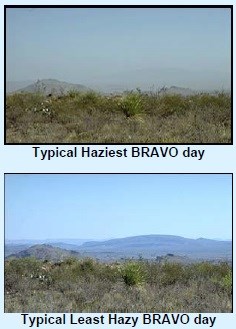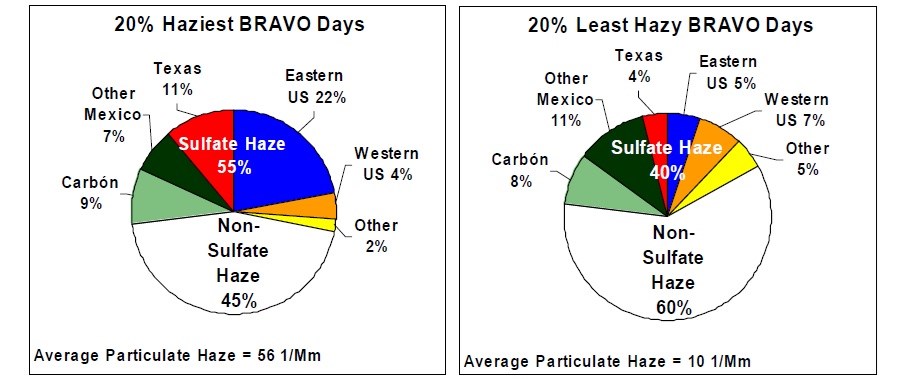|
In 1999, the Environmental Protection Agency issued a new regulation called the Regional Haze Rule. It calls for state and federal agencies to work together to improve visibility in 157 National Parks and wilderness areas, including Big Bend National Park. Analyses must be conducted to ensure that they reach natural background conditions within the next sixty years. That same year, the Environmental Protection Agency and the National Park Service teamed up to carry out the most sophisticated air pollution study every conducted, the B.R.A.V.O. Objectives of this study were to quantify the impacts of major pollution sources from Mexico and the United States on Big Bend National Park, determining what makes up park air pollution, the role of weather in park haze, and the paths that air pollution follows to reach the park. Data was collected from 42 different sites throughout Texas. Chemical tracers were released from specific locations and their movements were "tracked" by sensitive air samplers. The final report, released in September of 2004, contains a number of surprising results regarding the sources of air pollution in the Big Bend region. 
Results of the BRAVO StudyBackgroundThe scenic beauty of Big Bend National Park is often spoiled by haze that obscures its many vistas. In addition, Big Bend is one of the few national parks where haze has been increasing since the late 1980s. In 1999, the National Park Service and the U.S. Environmental Protection Agency carried out the Big Bend Regional Aerosol and Visibility Observational (BRAVO) study. Other participating agencies were the Texas Commission on Environmental Quality and the Electric Power Research Institute. The primary objective of BRAVO was to determine what causes the haze at Big Bend. The BRAVO study involved a four-month intensive monitoring period from July through October 1999, followed by a data analysis and modeling effort.Haze is caused by scattering and absorption of light (light extinction) by suspended particles in the air. Particles can stay suspended in the atmosphere for many days and be transported for hundreds of miles. The composition of the particles varies depending on their human and natural sources. Sulfate particles are the single largest contributor to haze at Big Bend NP, accounting for about half of the haze on the average and on the haziest days. Sulfate particles form in the atmosphere from chemical reactions of sulfur dioxide gas. Sources of sulfur dioxide include coal-fired power plants, metal smelters, refineries, other industrial processes and volcanoes. Dust from the suspension of soil particles and carbonaceous material from forest fires also affect haze at Big Bend. The haze in Big Bend NP peaks in the spring months (April–June), when both sulfate and carbonaceous particles are the dominant contributors, and the late summer and early fall months (August–October) when sulfate particles alone dominate. The least hazy conditions occur during the winter months. 
BRAVO AnalysesAfter the field measurement period, laboratory analyses of the air samples were completed. These analyses yielded the concentrations and chemical composition of the atmospheric particles and concentrations of unique tracer compounds that were released to assess transport. A number of data analysis methods were used to ascertain what source regions were contributing to the sulfate haze at Big Bend National Park. Some methods involved examining the relationships between different measured chemical components and unique tracer compounds, while others were based on numerical models of the meteorology, pollutant transport, and chemical reactions of the atmosphere. One aspect of the BRAVO study was the innovative way numerical atmospheric modeling was reconciled with the measured chemical compounds to give a more accurate assessment of the contributors to sulfate haze. The image above summarizes the contributions on the haziest and least hazy days during the study.BRAVO Findings
Next Steps for Improving Air Quality in Big BendIn general, sulfur dioxide emission reductions should help reverse the trend for worsening visibility in the Big Bend region. This is particularly true of sources in Texas and the eastern U.S, given the significance of the contribution from those regions. Sulfur dioxide emission reductions from the western U.S and Northern Mexico would help maintain and improve the least hazy days.There are current and pending federal regulations that should reduce sulfur dioxide emissions throughout the United States and make significant progress toward improving visibility in Big Bend National Park. Although sources in Mexico are also shown to contribute to visibility impairment at Big Bend National Park, the U.S. government has no jurisdiction there. There have been partnerships between agencies in Mexico and the U.S. to address transport of pollution. Such a partnership might be of use in the Big Bend Region. |
Last updated: July 10, 2018
